Set Up SMS Using Twilio
Introduction
This step-by-step guide will walk you through sending an SMS notification using Courier and Twilio. You will:
Prerequisites
You will need both Courier and Twilio accounts to complete this tutorial. If you don't have accounts already, sign up before proceeding.
Twilio Onboarding
When creating a Twilio account, Twilio will ask several questions to help customize your experience. Most importantly, Twilio will ask for a project name. You can provide your company name, app name, or something else appropriate (you can always change the project name later). This is necessary because Twilio will assign credentials unique to this project.
Add the Twilio Integration
Once logged in to Courier, navigate to the "Integrations" page. Click on the Twilio Integration to configure it.
Courier Integrations each require different pieces of information based on the needs of the Integration provider (see the requirements for each in the "Provider Documentation" section of the sidebar to the left). In the case of Twilio, we need an "Account SID," "Auth Token," and "Messaging Service SID." We will retrieve these from Twilio shortly.
Twilio Account SID and Auth Token
Once logged in to Twilio, navigate to the "Dashboard" by clicking the house icon on the sidebar.
This page will display a section labeled "Project Info" with your "Account SID" and "Auth Token." Paste these into the corresponding fields on Courier's Twilio Integration page.
Twilio Overview
To send messages, we need a Twilio phone number with SMS capabilities and a Twilio Messaging Service. We will walk through the basics together, but Twilio provides excellent documentation of their services as well.
Twilio Phone Numbers
First, purchase a Twilio phone number. Navigate to the "Phone Numbers" page of the Twilio console by clicking the circle icon in the sidebar, then "# Phone Numbers". Then, click on "Buy a Number".
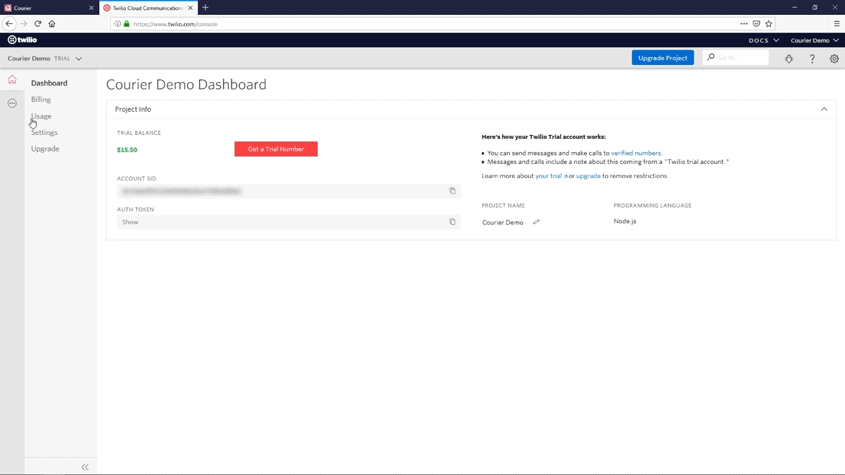
You can search either for a specific number or by location. Select a number capable of sending SMS messages. Check the "SMS" box to filter for numbers with this functionality. Then click "Search." Twilio will load a list of available numbers with the capabilities and the price of each number listed in a table.
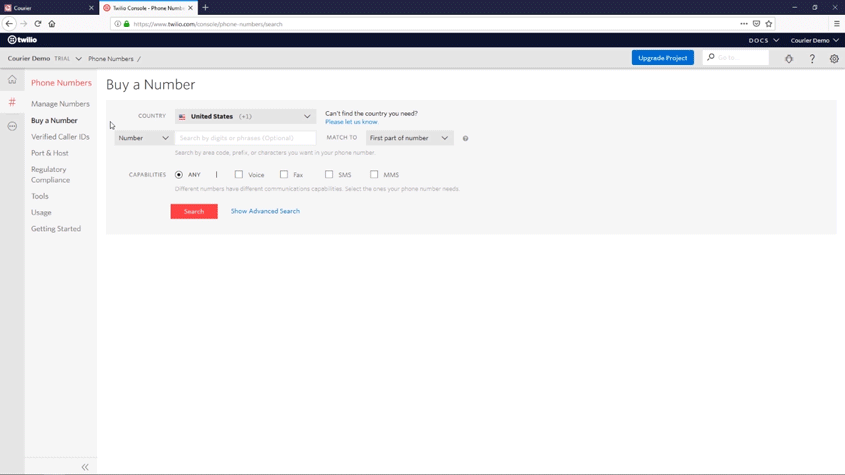
If you are new to Twilio, your trial account is initially funded with enough money to purchase a phone number and send many messages, so you won't have any expenses while completing this guide.
Select whichever available number appeals to you. You may be asked to comply with the regulatory requirements associated with the number — thorough regulatory documentation is provided by Twilio. Be sure to use your number responsibly and comply with any requirements.
Click the "Buy This Number" button, and then select, "Setup number." This will load a phone number configuration page. We don't need to change anything for this tutorial.
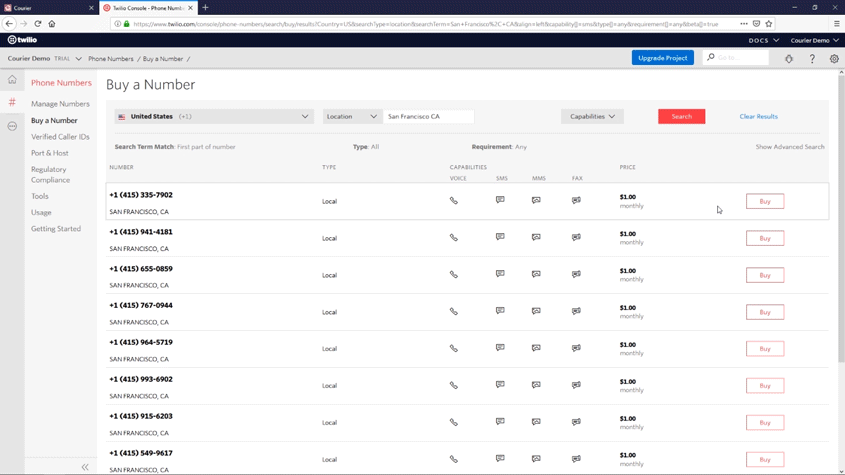
Twilio Messaging Service
Now that we have a phone number, we need to create a Twilio Messaging Service that uses this number. Navigate to the "Programmable SMS" section of the Twilio console. This will display a Messaging Services dashboard. Navigate to the "SMS" subsection in the sidebar.
This page displays a "Create new Messaging Service" link. Click this link to load a modal with two fields: "Friendly Name," and "Use Case."
Let's use "Courier SMS Service" for our "Friendly Name." There are several "Use Case" options. For this tutorial, we can select "Notifications, Outbound Only." For more about Twilio Messaging Services, see their "Sending Messages" guide. Next, click "Create."
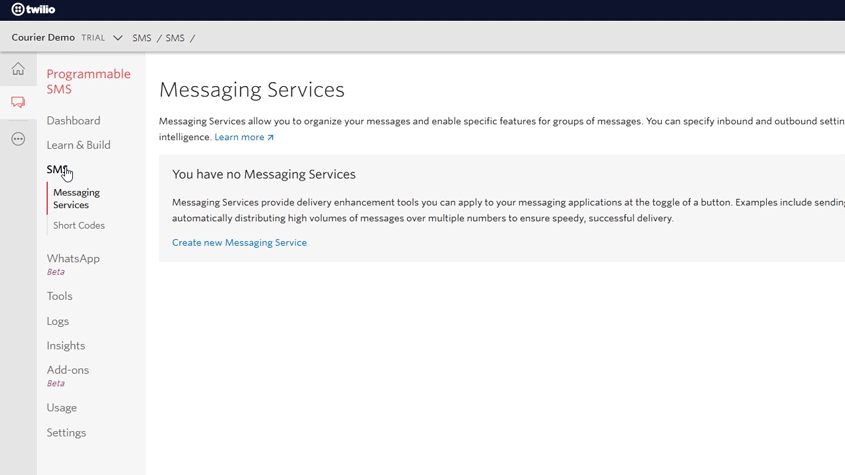
Twilio will load a configuration page for your service. Thankfully, you shouldn't have to change anything here. You need only the "Service SID" at the top of the page. Copy this SID, and enter it into the "Messaging Service SID" field on Courier's Twilio Integration page. Click the "Add Integration" button. Then, click "Save."
We have one thing left to configure. We must add our phone number to our Messaging Service. Go back to Twilio. Then navigate to your Twilio Messaging Service's configuration page. You will see two links in the sidebar beneath your "Courier SMS Service." Navigate to the "Numbers" subsection. This will load a page with an "Add an Existing Number" link. Click this link, and check the box to the right of the number you purchased earlier. Click "Add Selected."
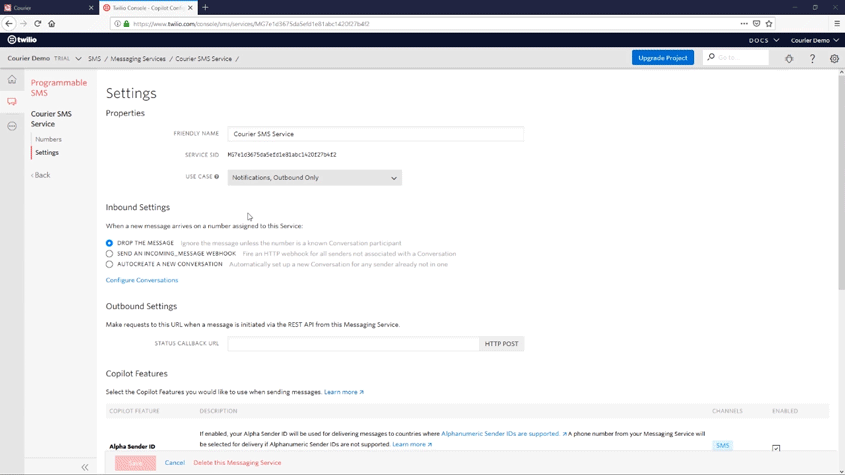
Create a Notification
Navigate to the Courier Notifications page and click “Create Notification”. Click on “Untitled Notification” to rename your notification — for this tutorial, call it “Test Appointment Reminder.” From your list of configured Integrations, click on the Twilio button. Then, click the “Twilio” box that has been added to the sidebar in order to bring up an SMS template.
You can add message blocks to the template by clicking one of the three icons on the mock-up smartphone. The paper icon adds a text block. The hand icon adds a link. The list icon adds a repeatable list.
These text blocks can include variables using a mustache-like template syntax. Surround text with a single set of curly braces and that text will be interpreted as a variable (it will also be highlighted in green). For example, you may want to include a {name} variable (we'll cover the source of this variable data later in this tutorial).
Finish populating the SMS template with whatever text you want to send. You can also copy the example below, which contains a few variables for demonstration.
Hello {name},
This is an appointment reminder from Courier. We look forward to seeing you on {apt_date} at {apt_time}.
If you need to change your appointment for any reason, please contact us at least 24 hours in advance at {support_url} or {support_phone}.
Best regards,
Courier
When you are finished, click Publish in the upper right corner and give it a Publish Message of "Initial notification."
Send a Message
Courier passes messages to Integrations via the Send endpoint. For this tutorial, we will send our messages with cURL, but you can use your preferred language and HTTP library. You can also use an API testing tool such as Postman or Insomnia. For additional code samples, see the "Courier API Reference".
Authorization
Courier supports both basic and token authorization. For this tutorial, we will use token authorization. You can read more about authorization in Courier's "Authorization Overview".
We must send an Authorization header with each request. The Courier Send API also requires an event. The authorization token and event values are the "Auth Token" and "Notification ID" we see in the detail view of our “Test Appointment Reminder” event. Click the gear icon next to the Notification's name to reveal them.
As a best practice, let's assign these values to environment variables. In a Bash terminal, you can add the variables by typing VARIABLE_NAME="<value>". Some examples are provided below. Note that the values are just examples. Do not copy them, and be sure to use the tokens associated with your account instead.
Courier Auth Token Variable
COURIER_AUTH_TOKEN="YpW2yEaMDyNg6agN9yGkc9ycEg8MxiKVTiiu2WVc8"
Notification ID
COURIER_NOTIFICATION_ID="YpW2yEaMDyNg6agN9yGkc9ycEg8"
These variables will persist for as long as your Bash session remains alive. If you quit your terminal, you will need to recreate them. However you handle your authorization tokens, keep them secure, and never add them to source control.
To verify that you created the variables correctly, you can see them by typing echo $VARIABLE_NAME. For example, typing echo $COURIER_AUTH_TOKEN will print the "Courier Auth Token" value to the terminal.
Building the cURL Request
We want to send a POST request to https://api.courier.com/send. Let's build our cURL request line-by-line. First, we'll tell cURL this is a POST request.
curl --request POST
Next, add the Authorization header using the COURIER_AUTH_TOKEN variable we set earlier. We send this as a Bearer token.
curl --request POST \
--header "Authorization: Bearer $COURIER_AUTH_TOKEN" \
We also have a Content-Type header, which is application/json.
curl --request POST \
--header "Authorization: Bearer $COURIER_AUTH_TOKEN" \
--header "Content-Type: application/json" \
We will pass the body of our request using the cURL --data option. You will often send this data in JSON format. To improve working with cURL, Courier also supports a custom urlencoded format that can be used in the place of JSON. This format allows nested data values using square bracket syntax. This guide provides examples in both formats, so feel free to use the format that you like best.
Our --data option must also contain an event and recipient. Additionally, we will send profile and data objects.
The event value, for this example, is the "Notification ID" that we assigned to our COURIER_NOTIFICATION_ID environment variable earlier.
A recipient should be a unique identifier that does not change. This prevents duplicate entries in the event that a recipient changes their email or some other identifying value. We do not have any recipients in this tutorial, so we can enter any string value. Something like “peter_parker” will work.
The profile information is an object that includes any key-value pairs required by our Integrations. In the case of Twilio, we need a phone_number key and value. This is the phone number where our message will be delivered. You can find the required keys for any Integration by selecting an Integration on the "Integrations" page. See the "Integration Provider Requirements" for details.
Lastly, we define message variables inside the data object. Remember the variables we set in the
visual template editor? This is where we provide the values. Our example message had name,
apt_date, apt_time, support_phone, and support_url variables. For this tutorial, we can
assign example strings to each.
Our --data option should look like this:
- JSON
- cURL
{
"event": "'"$COURIER_NOTIFICATION_ID"'",
"recipient": "peter_parker",
"profile": {
"phone_number": "555-616-1962"
},
"data": {
"name": "Peter Parker",
"apt_date": "August 27, 2020",
"apt_time": "11:00 AM",
"support_phone": "555-555-5555",
"support_url": "https://courier.com/docs"
}
}
--data "event=$COURIER_NOTIFICATION_ID" \
--data "recipient=peter_parker" \
--data "profile[phone_number]=555-616-1962" \
--data "data[name]=Peter Parker" \
--data "data[apt_date]=August 27" \
--data "data[apt_time]=11:00 AM" \
--data "data[support_phone]=555-555-5555" \
--data "data[support_url]=https://www.courier.com/docs/" \
Now add the Send URL, https://api.courier.com/send, to complete the cURL request.
Complete cURL Request in both Formats
- cURL in JSON
- cURL urlencoded
curl --request POST \
--header "Authorization: Bearer $COURIER_AUTH_TOKEN" \
--header "Content-Type: application/json" \
--data '{
"event": "'"$COURIER_NOTIFICATION_ID"'",
"recipient": "peter_parker",
"profile": {
"phone_number": "555-616-1962"
},
"data": {
"name": "Peter Parker",
"apt_date": "August 27",
"apt_time": "11:00 AM",
"support_phone": "555-555-5555",
"support_url": "https://courier.com/docs"
}
}' \
https://api.courier.com/send
curl --request POST \
--header "Authorization: Bearer $COURIER_AUTH_TOKEN" \
--header "Content-Type: application/json" \
--data "event=$COURIER_NOTIFICATION_ID" \
--data "recipient=peter_parker" \
--data "profile[phone_number]=555-616-1962" \
--data "data[name]=Peter Parker" \
--data "data[apt_date]=August 27" \
--data "data[apt_time]=11:00 AM" \
--data "data[support_phone]=555-555-5555" \
--data "data[support_url]=https://www.courier.com/docs/" \
https://api.courier.com/send
Before sending this request, be sure to replace the 555-616-1962 value with a phone number you can access. Also, note the "'"$COURIER_NOTIFICATION_ID"'" formatting in the JSON formatted --data option. The quotes are necessary to escape the JSON quotes and access the COURIER_NOTIFICATION_ID variable.
Paste your complete cURL request in either format in your terminal and hit "Return." You should receive a response like {"messageId":"<message id string>"}. You will also receive an SMS at the phone number you specified in the request body. If you do not receive a message, be sure the phone number provided in the profile is an approved number with Twilio. Twilio trial accounts may limit your ability to send messages to unknown numbers.
Congratulations, you’re on your way to crafting a better notification strategy that your audience is sure to appreciate.